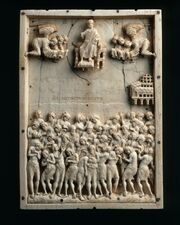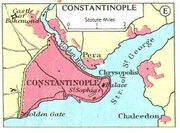
The Forty Martyrs of Sebaste, 10th Century CE. Ivory relief. Constantinople.
Brief Identification:[]
The Forty Martyrs of Sebaste as an example of Byzantine art from the tenth century CE. It was produced in Constantinople and is an example of an ivory relief. The relief depicts the martyrdom of forty Christian soldiers of the Legio XII Fulminata [Butler, www.ewtn.com/library/MARY/40MAR.htm][1]. The relief now resides in the Bode Museum in Berlin, Germany after their acquisition of it from the Dumbarton Oaks Byzantine Collection.
Technical Evaluation:[]
The Forty Martyrs of Sebaste is an ivory relief. Because of Constantinople’s position as a center for commerce and trade, ivory became very popular, particularly between the tenth and eleventh centuries [Rautman 2006, 264][2]. The Byzantine Empire acquired ivory through trading with Egyptian merchants, who had acquired the material from East Africa [Ryder, www.metmuseum.org/toah/hd/ivor/hd_ivor.htm][3]. Ivory became a precious material for developing icons (as opposed to previously used wood) because of its ability to be carved without distorting an icon’s intricacies. The details within ivory craftsmanship are primarily employed by the use of a scraper. The scraper has seven key patterns used to achieve intricate detail: the straight, the round, the half round, the point, the bead and the left and right side; ivory carving also uses “special-profile scrapers” to create “fixed patterns” [Ward 2008, 297-298][4]. Despite the widespread use of ivory in art, craftsmen did not stray from this traditional method for carving ivory.
Local Historical Context:[]
After the Iconoclastic Controversy, ivory made a prolific return into Byzantine artwork and was celebrated during the Feast of Orthodox, which is still observed today in the Eastern Orthodox Church [Encyclopedia Britannica Online; www.britannica.com/EBchecked/topic/281492/Iconoclastic-Controversy][5]. The Forty Martyrs of Sebaste was created post-Iconoclastic Controversy and between the reigns of Leo VI, the Wise through Basil II, Bulgaroktonos [Heilbrunn Timeline of Art History; www.metmuseum.org/toah/hd/byru/hd_byru.htm][6]. In Byzantium, the apori, ptochoi (or rural peasants and urban poor) constituted the largest of the three social classes. Most people were tenant farmers, however, craftsmen also fell into this class. Most craftsmen created their artworks as a means of income, not as a result of creative incentive [Laiou 2008, 546][7]. Nearly all Byzantine art was created in order to satisfy a societal need, and elaborate pieces were commissioned to serve a specific purpose, which is the case with the creation of the Forty Martyrs of Sebaste. Because of art being deemed as a purposeful necessity, nearly all Byzantine art is untraceable to its original maker, despite its detail, beauty, and technique [Rautman 2006, 257][8].
World Historical Significance:[]
The Forty Martyrs of Sebaste, as a specific work, pays homage to the martyrdom of the forty Christian sold

Byzantine Empire and its capital, Constantinople
iers of the Legio XII Fulminata under the leadership of their general, Lysias. Because of their proclamation as Christians to Emperor Licinius of Sebaste, Lesser Armenia (320 CE), they were exposed to the frigid winter, naked, beside a pond, under Licinius’ hopes that the soldiers would denounce their faith. Both, the survivors and the deceased who did not denounce their faith, were cast into a fire [Butler, www.ewtn.com/library/MARY/40MAR.htm][9]. The soldiers’ bravery was commended by the Byzantine Empire and has been commemorated through many different Byzantine art mediums, including that of a wooden icon, as well as the ivory relief of the 10th century, which is characteristic of the intentionality of Byzantine art.
Bibliography:[]
Butler, Alben. "40 Martyrs of Sebaste- 320 A.D." 40 Martyrs of Sebaste. January 1, 1864. Accessed April 19, 2015. http://www.ewtn.com/library/MARY/40MAR.htm.
"Heilbrunn Timeline of Art History." List of Rulers of Byzantium. October 1, 2003. Accessed April 19, 2015. http://www.metmuseum.org/toah/hd/byru/hd_byru.htm.
"Iconoclastic Controversy | Byzantine History." Encyclopedia Britannica Online. Accessed April 19, 2015. http://www.britannica.com/EBchecked/topic/281492/Iconoclastic-Controversy.
Laiou, Angeliki E. The Economic History of Byzantium: From the Seventh through the Fifteenth Century. Washington, D.C.: Dumbarton Oaks Research Library and Collection, 2002.
Rautman, Marcus Daily Life in the Byzantine Empire, 257-258. Westport, Connecticut: Greenwood Press, 2006.
Ryder, Edmund C. "Heilbrunn Timeline of Art History." Byzantine Ivories. October 1, 2007. Accessed April 19, 2015. http://www.metmuseum.org/toah/hd/ivor/hd_ivor.htm.
Ward, Gerald W.R. The Grove Encyclopedia of Materials and Techniques in Art, 297-298. Oxford: Oxford University Press, 2008.
Footnotes:[]
[1] Butler, Alben. "40 Martyrs of Sebaste- 320 A.D." 40 Martyrs of Sebaste. January 1, 1864. Accessed April 19, 2015. http://www.ewtn.com/library/MARY/40MAR.htm.
[2] Rautman, Marcus Daily Life in the Byzantine Empire, 257-258. Westport, Connecticut: Greenwood Press, 2006.
[3] Ryder, Edmund C. "Heilbrunn Timeline of Art History." Byzantine Ivories. October 1, 2007. Accessed April 19, 2015.http://www.metmuseum.org/toah/hd/ivor/hd_ivor.htm.
[4] Ward, Gerald W.R. The Grove Encyclopedia of Materials and Techniques in Art, 297-298. Oxford: Oxford University Press, 2008.
[5] "Iconoclastic Controversy | Byzantine History." Encyclopedia Britannica Online. Accessed April 19, 2015. http://www.britannica.com/EBchecked/topic/281492/Iconoclastic-Controversy.
[6] "Heilbrunn Timeline of Art History." List of Rulers of Byzantium. October 1, 2003. Accessed April 19, 2015. http://www.metmuseum.org/toah/hd/byru/hd_byru.htm.
[7] Laiou, Angeliki E. The Economic History of Byzantium: From the Seventh through the Fifteenth Century. Washington, D.C.: Dumbarton Oaks Research Library and Collection, 2002.
[8] Rautman, Marcus Daily Life in the Byzantine Empire, 257-258, 264. Westport, Connecticut: Greenwood Press, 2006.
[9] Butler, Alben. "40 Martyrs of Sebaste- 320 A.D." 40 Martyrs of Sebaste. January 1, 1864. Accessed April 19, 2015. http://www.ewtn.com/library/MARY/40MAR.htm.